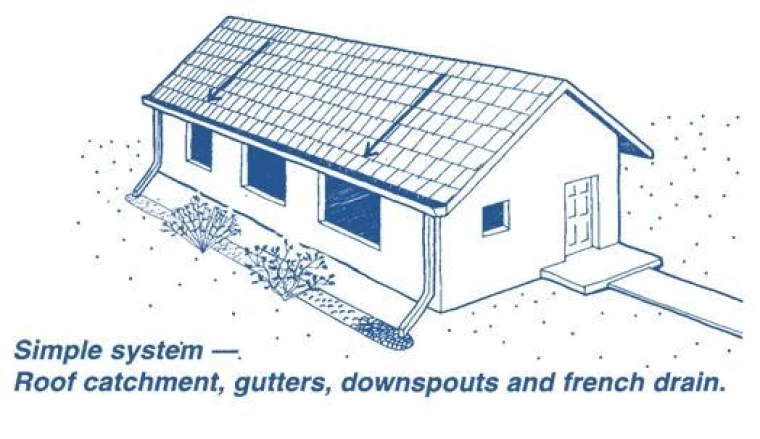
Monsoon rains should be a great benefit to landscape plants. But if the rainwater simply runs off of your property, you're not getting the full benefit of all that moisture! Think there isn't enough rain? A one-inch rain will collect 600 gallons from a 1,000 square foot roof, while 4,500 square foot lot will receive 2,800 gallons!
Two easy ways to collect rainwater
- "Passive" collection: where you catch stormwater as it moves across your property. Download this Fact Sheet about Passive Rainwater Harvesting.
- "Active" collection: where you catch rainwater in a container. Download this Fact Sheet about Active Rainwater Harvesting!
How Much Rain Can You Catch?
Here is an easy formula:
- Measure the square footage of the collection area (for example a roof that is 30 feet wide x 50 feet long = 1500 ft2)
- Multiply the area by the amount of rain in inches
- Multiply that number by 0.623 (that is the quantity of water in gallons one inch deep in one square foot of space)
This will equal the number of gallons which can be collected.
Landscapes and hard surfaces can be designed and modified to hold, direct and distribute rainwater to plants with rainwater harvesting.
Preventing water from rapidly running off of the landscape is of primary importance. Porous paving materials such as bricks and special asphalt can allow water to penetrate. Angling hard surfaces to drain to planted areas instead of off the property can supplement irrigated areas.
Many backyards of urban properties are bordered by privacy walls. These walls have openings at the base to allow water to drain out.
Partially blocking these openings for a time can hold in rainwater, giving it a chance to soak into the ground. Caution must be taken, however, not to block the escape of the water to the extent that flooding of the home occurs.

Example
1500 square feet of roof area x 15 inches of rain x 0.623 = 14,017 gallons
Literature
- "At a Glance" Information
- How to Collect in a Container ("active" collection)
- How to Collect Stormwater ("passive" collection)
- Maintaining your Residential Water Harvesting System
- Rainwater Supplies
- First Flush Systems
- 55 Gallon Barrel Design
- 170 Gallon Water Trough Design
- Water Budget Calculator (email request)
- RainScapes
- Rain Gardens
- How to Build a Rain Barrel
- RWH Tour 2018 Info Post Cards
- How to Estimate Your Rain Harvesting and Gray Watering Potential
- Choosing Large-Scale Rain Harvesting for Potable Supply
- Preparing Rainwater for Potable Use
Videos
- We Finish Building The Massive Earthbag Wall For Our Rainwater Harvesting Cistern (Green Dream Project)
- Where We Got Our Earthbags | Sandbags | For Earthbag Building | Where We Got Our Pond Liner (Green Dream Project)
- Rainwater Harvesting Series Texas A & M
- Learn how to use a water level (bunyip) 1
- Learn how to build a berm with a water level (bunyip) 2
- How to build a rain roof for a wildlife guzzler by Homsteadonomics
- How to build a freestanding rain roof by Homsteadonomics
- Building a 28,000-gallon Rainwater Tank – Handeeman
- AMAZINGLY Simple Rain Roof –Handeeman
- Rain for People and Plants: A Rain Harvesting Talk
The information given herein is supplied with the understanding that no discrimination is intended and no endorsement by The University of Arizona Cooperative Extension is implied.
Cochise County Rain Harvesting Fact Sheets
- The Discovery Gardens at The University of Arizona Cooperative Extension Sierra Vista
- Sierra Vista Self-Guided Rain Harvesting Tour
- City of Bisbee RWH Fact Sheet
- Cochise College RWH Fact Sheet
- Naco Border Patrol RWH Fact Sheet
- Sonic Drive-In RWH Fact Sheet
- Sierra Vista Police Station RWH Fact Sheet
- Huachuca City Community Garden


